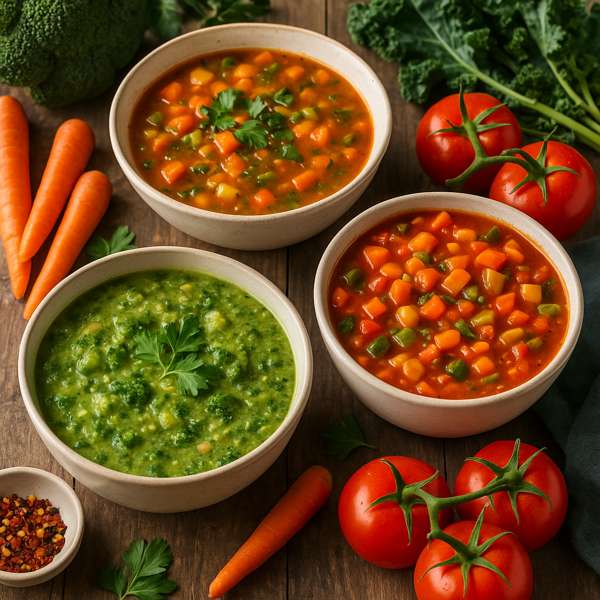Creative Ways to Sneak Vegetables into Your Child’s Diet
Getting kids to eat their vegetables can be a challenge. Many children are picky eaters and prefer sweet or salty foods over healthy greens. But, there are clever ways to add veggies to meals without them noticing. This article will explore some creative methods to sneak vegetables into your child’s diet. These tips can make meals healthier and more colorful. Let’s dive into the world of hidden vegetables and discover how you can boost your child’s nutrition effortlessly.
Blend Vegetables into Smoothies
![]()
One great way to get kids to eat vegetables is by blending them into smoothies. Smoothies are sweet and delicious, making them a favorite for many children. When you mix fruits with vegetables, the sweet flavors can hide the taste of greens.
- Spinach is a good choice for smoothies. It has a mild taste and blends well with fruits like bananas and berries.
- Kale is another option. It is full of vitamins and blends well with pineapple and mango.
- Carrots can also be used. They are sweet and pair nicely with oranges and peaches.
Adding yogurt or milk can make the smoothie creamy. You can even use almond or soy milk if your child is lactose intolerant. Try different combinations to find what your child likes best. Many parents have successfully used this method to increase their children’s vegetable intake.
A study showed that children who drank smoothies with hidden vegetables increased their veggie consumption by 50%. So, next time your child asks for a snack, try making a yummy smoothie packed with secret veggies!

Incorporate Veggies into Sauces
![]()
Sauces are another excellent way to sneak vegetables into your child’s diet. Kids love pasta and pizza, which often come with tomato-based sauces. Why not add some extra nutrition by mixing in veggies?
- Carrots and zucchini can be grated and mixed into tomato sauce. They cook down and blend in easily.
- Bell peppers can be chopped finely and added for an extra vitamin boost.
- Cauliflower can be pureed and stirred into creamy sauces for mac and cheese.
These additions can enhance the flavor while adding important nutrients. Plus, the vegetables become almost invisible in the sauce. Your child won’t even know they’re eating something healthy!
Many parents have found that this technique works well for picky eaters who refuse to eat vegetables on their own. By incorporating veggies into sauces, you can ensure your child gets the vitamins they need for growth and development.
Hide Veggies in Baked Goods
![]()
Baked goods like muffins, pancakes, and cookies can also be a vehicle for hidden vegetables. Baking allows you to disguise veggies in sweet treats that kids enjoy.
- Zucchini can be grated and added to muffin or bread batter. It’s moist and blends well with chocolate or banana flavors.
- Pumpkin puree is perfect for pancakes. It adds sweetness and color.
- Sweet potatoes can be mashed and mixed into cookie dough. They add natural sweetness and fiber.
This method is not only fun but also nutritious. You can turn dessert time into an opportunity to increase your child’s veggie intake. Many families have shared success stories about sneaking veggies into baked goods, making it a win-win situation for both kids and parents.
According to a survey, 70% of parents reported their kids ate more veggies when disguised as part of a treat. So, why not try baking some veggie-filled goodies today?

Use Veggies as Pasta Alternatives
![]()
Another creative way to include vegetables in your child’s diet is by using them as pasta alternatives. Many kids love pasta, so this can be a great opportunity to introduce more veggies.
- Zoodles, or zucchini noodles, are a popular choice. They look like spaghetti and taste great with marinara sauce.
- Spaghetti squash is another option. When cooked, it forms strands similar to pasta.
- Carrot ribbons can be made using a peeler. They add color and crunch to any dish.
These alternatives are not only lower in calories but also rich in vitamins and minerals. They can be paired with your child’s favorite sauces and toppings, ensuring a meal they will enjoy.
Parents have found that using veggie-based pastas encourages children to try new foods. It’s a simple way to add variety and nutrition to their diet.
Make Veggie-Packed Soups
![]()
Soups are an easy and comforting way to include vegetables in your child’s meals. They are warm, tasty, and can be filled with hidden vegetables.
- Puree vegetables like carrots, peas, and tomatoes to make a smooth and creamy soup.
- Add small pieces of broccoli or spinach to chicken noodle soup for added nutrition.
- Use vegetable broth as a base to boost flavor and vitamins.
By blending vegetables into soups, you create a dish that’s both delicious and healthy. This method is especially useful during colder months when soups are a family favorite.
Statistics show that children are more likely to eat vegetables when they are part of a flavorful dish like soup. This makes soups a practical choice for parents looking to improve their child’s diet.

Experiment with Veggie Snacks
![]()
Veggie snacks can be a fun and exciting way to encourage your child to eat more vegetables. Snacking is an important part of a child’s day, and it’s a chance to offer healthy options.
- Make crispy kale chips by baking kale leaves with a little olive oil and salt.
- Create cucumber sandwiches using slices of cucumber instead of bread.
- Offer bell pepper strips with hummus or guacamole for dipping.
These snacks are not only nutritious but also visually appealing. They offer a variety of textures and flavors that kids may find interesting. Experiment with different veggies and dips to find out what your child prefers.
Case studies have shown that children who are offered a variety of veggie snacks are more open to trying new vegetables. This approach can help develop healthy eating habits from a young age.
Conclusion: Creative Ways to Sneak Vegetables into Your Child’s Diet
![]()
In conclusion, sneaking vegetables into your child’s diet doesn’t have to be difficult. By using these creative methods, you can ensure they receive essential nutrients without them even realizing it. From smoothies and sauces to baked goods and snacks, there are plenty of opportunities to incorporate veggies into meals. Encourage your child to try new foods and make mealtime fun and nutritious. With these tips, you’ll be able to boost your child’s health and set them up for a lifetime of healthy eating habits.




